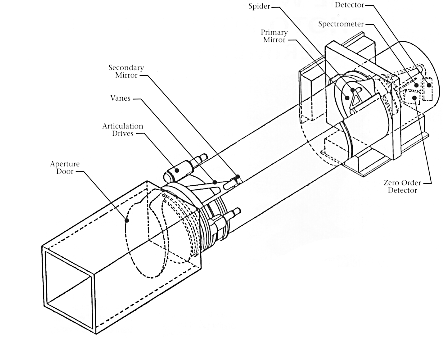 Further information can be found on the
WUPPE home page.
Further information can be found on the
WUPPE home page.

Principal Investigator: Dr. Arthur D. Code
Developing Institution: University of Wisconsin
Telescope Optics: Cassegrain system, f/10 focal ratio
Instrument: Spectropolarimeter with dual
electronic diode array detectors
Primary Mirror: 50 centimeters (20 inches) diameter
1,800 square centimeters
(279 square inches) area
Field of View: 3.3 x 4.4 arc-minutes
Spectral Resolution: 6 angstroms
Wavelength Range: 1,400 to 3,200 angstroms
Magnitude Limit: 16
Weight: 446 kilograms (981 pounds)
Dimensions: 70 centimeters (28 inches) diameter
3.7 meters (12.14 feet) length
The Wisconsin Ultraviolet Photo-Polarimeter Experiment (WUPPE) is a pioneering effort to explore polarization and photometry in the ultraviolet (UV) spectrum. The instrument measures polarization by splitting the beam of radiation entering the telescope into two perpendicular planes of polarization. The beams are then passed through a spectropolarimeter and focused on separate array detectors for photometric measurements.
The Cassegrain-type telescope uses a 50-centimeter (20-inch) diameter f/10 mirror with an area of 1,800 square centimeters (279 square inches) as its primary reflector. The instrument examines UV radiation from 1,400 to 3,200 angstroms with a field of view of 3.3 by 4.4 arc minutes and a resolution of 6 angstroms. The light is fed into a Monk-Gilleson spectrometer, where two rotating wheels are used to select the focal plane aperture and the polarimetric analyzer. The detector consists of dual Reticon self-scanning linear arrays of 1,024 photodiodes coupled by fiber optics to a microchannel plate with a cesium-telluride photocathode. A charge-coupled device camera is provided for target acquisition and for viewing the aperture during a measurement.
The Wisconsin Ultraviolet Photo-Polarimeter Experiment gives a more general description WUPPE's capabilities.
 Further information can be found on the
WUPPE home page.
Further information can be found on the
WUPPE home page.
Mary Romelfanger (mary@pha.jhu.edu)